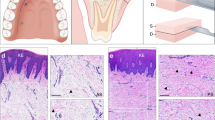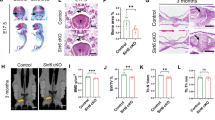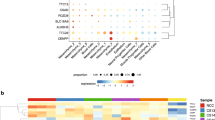Abstract
Background
Cleft palate (CP) constitutes the most frequently seen orofacial cleft and is often associated with low folate status. Folate plays an essential role in the human body as a major coenzyme in one-carbon metabolism, including DNA synthesis, repair, and methylation. Whether the administration of isolated folic acid (FA) supplements prevents the CP caused by genetic mutations is unknown, as is its effect on the mechanisms leading to palate fusion.
Methods
FA was administered to females from two different strains of transforming growth factor β3 heterozygous mice. Null mutant progeny of these mice exhibit CP in 100% of cases of varying severity. We measured cleft length, height of palatal shelf adhesion, and the number of proliferating mesenchymal cells. Immunohistochemistry was also carried for collagen IV, laminin, fibronectin, cytokeratin-17, and EGF.
Results
FA supplementation significantly reduced CP severity and improved palatal shelf adhesion in both strains both in vivo and in vitro. Medial edge epithelium proliferation increased, and its differentiation was normalized as indicated by the presence and disposition of collagen IV, laminin, fibronectin, and cytokeratin-17.
Conclusions
A maternal FA supplementation reduces the CP appearance by improving the mechanisms leading to palatal shelf adhesion.
Similar content being viewed by others
Log in or create a free account to read this content
Gain free access to this article, as well as selected content from this journal and more on nature.com
or
References
Ferguson, M. W. Palate development. Development 103(Suppl), 41–60 (1988).
Martínez-Alvarez, C. et al. Bulging medial edge epithelial cells and palatal fusion. Int. J. Dev. Biol. 44, 331–335 (2000).
Gato, A. et al. TGF-beta(3)-induced chondroitin sulphate proteoglycan mediates palatal shelf adhesion. Dev. Biol. 250, 393–405 (2002).
Tudela, C. et al. TGF-beta3 is required for the adhesion and intercalation of medial edge epithelial cells during palate fusion. Int. J. Dev. Biol. 46, 333–336 (2002).
Martínez-Sanz, E. et al. Alteration of medial-edge epithelium cell adhesion in two Tgf-beta3 null mouse strains. Differentiation 76, 417–430 (2008).
Murillo, J. et al. Interactions between TGF-beta1 and TGF-beta3 and their role in medial edge epithelium cell death and palatal fusion in vitro. Differentiation 77, 209–220 (2009).
Mossey, P. A., Little, J., Munger, R. G., Dixon, M. J. & Shaw, W. C. Cleft lip and palate. Lancet 374, 1773–1785 (2009).
Mehrotra, D. Genomic expression in non syndromic cleft lip and palate patients: a review. J. Oral. Biol. Craniofac. Res. 5, 86–91 (2015).
Burg, M. L., Chai, Y., Yao, C. A., Magee, W. & Figueiredo, J. C. Epidemiology, etiology, and treatment of isolated cleft palate. Front Physiol. 7, 67 (2016).
Cox, L. L. et al. Mutations in the epithelial cadherin-p120-catenin complex cause Mendelian non-syndromic cleft lip with or without cleft palate. Am. J. Hum. Genet. 102, 1143–1157 (2018).
Lucock, M. Folic acid: nutritional biochemistry, molecular biology, and role in disease processes. Mol. Genet. Metab. 71, 121–138 (2000).
Molloy, A. M. et al. Low blood folates in NTD pregnancies are only partly explained by thermolabile 5,10-methylenetetrahydrofolate reductase: low folate status alone may be the critical factor. Am. J. Med. Genet. 78, 155–159 (1998).
Maldonado, E. et al. Tongue abnormalities are associated to a maternal folic acid deficient diet in mice. Nutrients 10, E26 (2017).
Maldonado, E. et al. Craniofacial structure alterations of foetuses from folic acid deficient pregnant mice. Ann. Anat. 218, 59–68 (2018).
Kelly, D., O’Dowd, T. & Reulbach, U. Use of folic acid supplements and risk of cleft lip and palate in infants: a population-based cohort study. Br. J. Gen. Pract. 62, e466–e472 (2012).
Czeizel, A. E. & Dudás, I. Prevention of the first occurrence of neural-tube defects by periconceptional vitamin supplementation. N. Engl. J. Med. 327, 1832–1835 (1992).
Maldonado, E. et al. Occurrence of cleft-palate and alteration of Tgf-β(3) expression and the mechanisms leading to palatal fusion in mice following dietary folic-acid deficiency. Cells Tissues Organs 194, 406–420 (2011).
Yao, Z. et al. Folic acid rescue of ATRA-induced cleft palate by restoring the TGF-β signal and inhibiting apoptosis. J. Oral. Pathol. Med. 40, 433–439 (2011).
Paros, A. & Beck, S. L. Folinic acid reduces cleft lip [CL(P)] in A/WySn mice. Teratology 60, 344–347 (1999).
Proetzel, G. et al. Transforming growth factor-beta 3 is required for secondary palate fusion. Nat. Genet 11, 409–414 (1995).
del Río, A. et al. Analysis of the presence of cell proliferation-related molecules in the Tgf-β3 null mutant mouse palate reveals misexpression of EGF and Msx-1. Cells Tissues Organs 193, 135–150 (2011).
National Research Council (US) Subcommittee on Laboratory Animal Nutrition. Nutrient Requirements of Laboratory Animals, Fourth Revised Edition, 1995 (National Academies Press, Washington (DC), 1995). (http://www.ncbi.nlm.nih.gov/books/NBK231927/).
Achon, M., Alonso-Aperts, E. & Varela-Moreiras, G. High dietary folate supplementation: effects on diet utilization and methionine metabolism in aged rats. J. Nutr. Health Aging 6, 51–54 (2002).
Giugliani, E. R., Jorge, S. M. & Gonçalves, A. L. Serum and red blood cell folate levels in parturients, in the intervillous space of the placenta and in full-term newborns. J. Perinat. Med. 13, 55–59 (1985).
Hyun, T. H. & Tamura, T. Trienzyme extraction in combination with microbiologic assay in food folate analysis: an updated review. Exp. Biol. Med. (Maywood) 230, 444–454 (2005).
Horne, D. W. & Patterson, D. Lactobacillus casei microbiological assay of folic acid derivatives in 96-well microtiter plates. Clin. Chem. 34, 2357–2359 (1988).
Tamura, T. in Folic Acid Metabolism in Health and Disease (eds Piccairo, M. F., Stokstad, R. & Gregory, J. F.) 121–137 (Wiley-Liss, Inc., New York, 1990).
Blakley, R. in Frontiers of Biology, Vol. 13 (eds Neuberger, A. & Tatum, E. L.) 63–105 (North-Holland Publishing, Amsterdam, 1969).
Richardson, R. et al. p63 exerts spatio-temporal control of palatal epithelial cell fate to prevent cleft palate. PLoS Genet. 13, e1006828 (2017).
Barrio, M. C. et al. Epidermal growth factor impairs palatal shelf adhesion and fusion in the Tgf-β 3 null mutant. Cells Tissues Organs 199, 201–211 (2014).
Kriangkrai, R., Chareonvit, S., Iseki, S. & Limwongse, V. Pretreatment effect of folic acid on 13-cis-RA-induced cellular damage of developing midfacial processes in cultured rat embryos. Open Dent. J. 11, 200–212 (2017).
Wahl, S. E. et al. The role of folate metabolism in orofacial development and clefting. Dev. Biol. 405, 108–122 (2015).
Xiao, W. L., Wu, M. & Shi, B. Folic acid rivals methylenetetrahydrofolate reductase (MTHFR) gene-silencing effect on MEPM cell proliferation and apoptosis. Mol. Cell Biochem. 292, 145–154 (2006).
Machacek, C. et al. Folate receptor β regulates integrin CD11b/CD18 adhesion of a macrophage subset to collagen. J. Immunol. 197, 2229–2238 (2016).
Hsieh, C.-L. et al. Valproic acid substantially downregulated genes folr1, IGF2R, RGS2, COL6A3, EDNRB, KLF6, and pax-3, N-acetylcysteine alleviated most of the induced gene alterations in chicken embryo model. Rom. J. Morphol. Embryol. 54, 993–1004 (2013).
Hosokawa, Y. et al. Serum type IV collagen concentration correlates with indocyanine green retention rate and is an indicator of hepatotoxicity in patients receiving FOLFOX for colorectal cancer. Hepatogastroenterology 62, 653–656 (2015).
Figini, M. et al. Reversion of transformed phenotype in ovarian cancer cells by intracellular expression of anti folate receptor antibodies. Gene Ther. 10, 1018–1025 (2003).
Ke, C.-Y., Xiao, W.-L., Chen, C.-M., Lo, L.-J. & Wong, F.-H. IRF6 is the mediator of TGFβ3 during regulation of the epithelial mesenchymal transition and palatal fusion. Sci. Rep. 5, 12791 (2015).
Wehby, G. L. et al. High dosage folic acid supplementation, oral cleft recurrence and fetal growth. Int. J. Environ. Res. Public Health 10, 590–605 (2013).
Pickell, L. et al. High intake of folic acid disrupts embryonic development in mice. Birth Defects Res. Part A Clin. Mol. Teratol. 91, 8–19 (2011).
Acknowledgements
The authors wish to thank Ms. Alicia Cerro and Ms. Dolores Arroyo (Universidad Complutense) for their assistance with the histology. We also thank the technical team of the Centro de Microscopía y Citometría of the Universidad Complutense for their assistance with the assessment of cell proliferation and Professor Colin Robinson (University of Leeds), the anonymous referees, and Proof-Reading-Service UK for their helpful suggestions and English editing of this manuscript.
Funding
This study was supported by grants to the Complutense Research Group 920202 from the Spanish Ministerio de Economía y Competitividad (PS09/01762) and Banco Santander-Universidad Complutense Madrid (PR41/17-21009).
Author information
Authors and Affiliations
Contributions
Y.L.-G., E.M., L.N., E.M.-S., I.P.-L., M.I.A., and T.P. took care of the animals and/or acquired the data. Y.L.-G., A.d.R., M.C.B., J.M., and C.M.-Á. analyzed the results obtained. C.M.-Á. designed the experiments and wrote the manuscript. All authors approved the manuscript before submission.
Corresponding author
Ethics declarations
Competing interests
The authors declare no competing interests.
Additional information
Publisher’s note: Springer Nature remains neutral with regard to jurisdictional claims in published maps and institutional affiliations.
Rights and permissions
About this article
Cite this article
López-Gordillo, Y., Maldonado, E., Nogales, L. et al. Maternal folic acid supplementation reduces the severity of cleft palate in Tgf-β3 null mutant mice. Pediatr Res 85, 566–573 (2019). https://doi.org/10.1038/s41390-018-0267-6
Received:
Revised:
Accepted:
Published:
Issue date:
DOI: https://doi.org/10.1038/s41390-018-0267-6
This article is cited by
-
Alterations of senescence-associated markers in patients with non-syndromic cleft lip and palate
Scientific Reports (2024)



